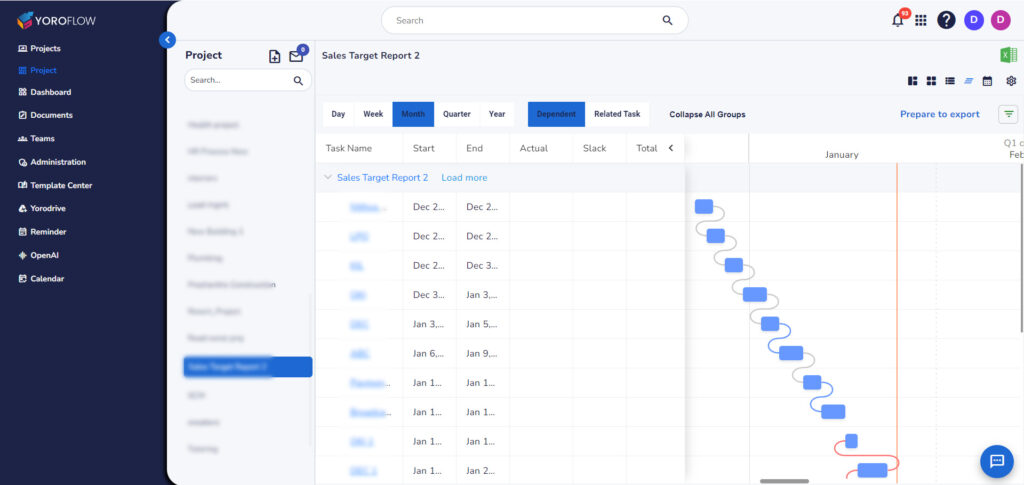Table of Contents
Project tracking acts as a guiding compass, providing a clear direction for your project. This method helps you monitor resource usage and compare it against your initial plans, ensuring that teams stay on schedule and resources are allocated efficiently.
Clear objectives, strategic planning, and defined roles are essential components of successful project tracking. By implementing this method, managers can proactively steer teams back on course, update senior management, and address potential issues before they escalate, ultimately saving time, money, and effort.
If you’re looking for practical insights on project tracking without the complexity, you’ve come to the right place. Explore how to monitor your project’s progress closely, ensuring it stays on the path to success with precision and clarity.
What is Project Tracking?
Project tracking is the process of monitoring and managing various aspects of a project to ensure that it stays on track and meets its goals. It involves closely monitoring the project’s progress, identifying any deviations from the plan, and taking corrective action to keep the project on course. Project tracking typically involves tracking key metrics such as task completion, resource usage, budget, and timeline. By regularly tracking these metrics, project managers can identify potential issues early and make informed decisions to keep the project on schedule and within budget.
The Pillars of Project Tracking
The pillars of project tracking can be summarized as follows:
- Clear Objectives: Establishing clear, achievable goals is essential for effective project tracking. These objectives serve as the foundation for monitoring progress and measuring success.
- Strategic Planning: Developing a detailed project plan that outlines tasks, timelines, resources, and milestones is crucial. This plan serves as a roadmap for the project and provides a framework for tracking progress.
- Resource Allocation: Efficient allocation of resources, including time, budget, and personnel, is key to successful project tracking. Monitoring resource usage helps identify any inefficiencies and ensures resources are used effectively.
- Task Management: Managing tasks and deadlines is essential for keeping the project on track. This involves assigning tasks, setting deadlines, and monitoring progress to ensure that tasks are completed on time.
- Risk Management: Identifying and mitigating risks is an important part of project tracking. By anticipating potential bottlenecks and developing contingency plans, project managers can minimize the impact of risks on the project.
- Communication: Effective communication is crucial for project tracking. Keeping stakeholders informed about progress, challenges, and changes helps ensure alignment and enables timely decision-making.
- Performance Monitoring: Regularly monitoring key performance indicators (KPIs) allows project managers to assess progress and identify any deviations from the plan. This information helps in making informed decisions to keep the project on track.
- Adaptability: Being adaptable and flexible is essential for successful project tracking. Projects often encounter unexpected challenges or changes, and the ability to adapt and adjust plans accordingly is crucial for success.
Tools and Techniques for Effective Project Tracking
Choosing the correct project management software can significantly increase your team’s efficiency, allowing them to focus more on ensuring the project’s success. This is especially important as 99% of megaprojects fail due to overcomplexity, highlighting the importance of proper management.
Project management tools are designed to assist your project in planning, tracking, automating, and managing projects of various sizes. The right tool can expedite goal achievement and help you stay within budget. However, the real challenge lies in finding the ideal fit for your specific project needs.
Here are some tools and techniques for effective project tracking:
- Project Management Software: Utilizing project management software can streamline tracking by providing a centralized platform for managing tasks, timelines, resources, and communication. Popular option includes YoroProject.
- Gantt Charts: Gantt charts visually represent project schedules, showing tasks, dependencies, and timelines. They are useful for tracking progress and identifying potential delays.

- Kanban Boards: Kanban boards provide a visual overview of tasks, allowing team members to see what needs to be done, what’s in progress, and what’s completed. Tools like Trello and Jira offer Kanban board features.
- Time Tracking Tools: Time tracking tools help monitor how much time is spent on each task, allowing for better resource allocation and identifying areas for improvement.
- Performance Metrics: Establishing key performance indicators (KPIs) helps track project progress and measure success. Metrics such as budget variance, schedule variance, and task completion rate are commonly used.
- Regular Status Meetings: Holding regular status meetings keeps the team informed about progress, challenges, and upcoming tasks. It also provides an opportunity to address any issues and adjust plans as needed.
- Risk Management Techniques: Identifying and mitigating risks is crucial for project success. Techniques such as risk assessment, risk monitoring, and contingency planning help manage risks effectively.
- Feedback Loops: Establishing feedback loops allows team members to provide input and suggestions for improving processes and addressing challenges.
By utilizing these tools and techniques, project managers can effectively track progress, identify issues early, and ensure that projects are completed on time and within budget.
Finally
As you continue, you likely recognize the crucial role that project management software and reporting play in project management. Together, they not only gather valuable project information but also disseminate it throughout the team, ensuring everyone stays informed. Without both tracking and reporting, you’re essentially navigating in the dark.
The strategies outlined in this guide will help ensure that all team members have a clear roadmap and can monitor progress in real-time. We encourage you to integrate these insights into your project management practices. Experiment with different dashboards, refine your communication strategies, and keep your objectives in focus.



